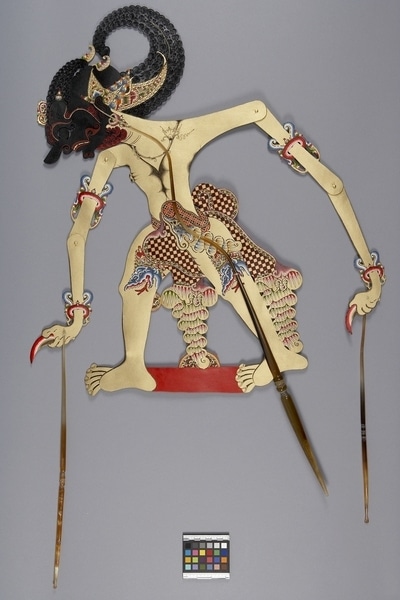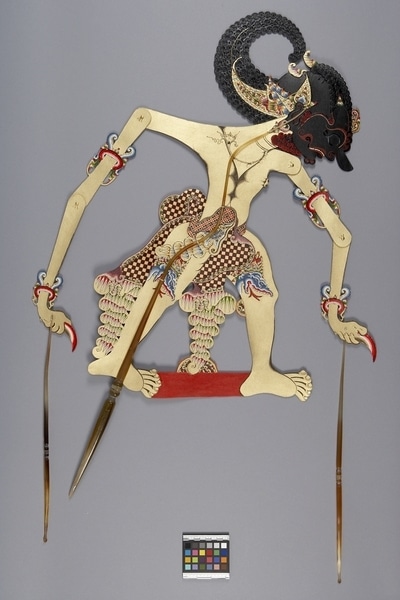Shadow Puppet Item Number: 1374/28 from the MOA: University of British Columbia


Description
A flat tall puppet painted gold-coloured. Represents the character Bima, Pandhawa Prince. The curly black hair curves backward and upward. The black face is accentuated with red. The lower garment is black, red, and gold-coloured checkered edged with a green, red, pink, white, black, and gold-coloured floral design. There is also an alternating green and red downward spike design. There is a matching headdress. The feet are connected with a horizontal red band. The feet and the head face to the puppet's left. Each arm has a red shoulder band and bracelet which has two blue curly protrusions. The shoulders and elbows are rotatable and a marionette stick is attached through the palm of each hand.
History Of Use
Wayang kulit shadow play is over a thousand years old. It is thought to be derived from the leather shadow puppetry of southern India, like tholu bommalata, which came to Java with the spread of Hinduism in the first millennium. In Java--part of the largely Islamic Republic of Indonesia--this highly distinctive form of shadow puppetry is valued as a pusaka, a sacred treasure of the royal court of Yogyakarta. The plays are performed to mark special occasions, such as birthdays, marriages, and religious events. They have also been adapted for television and for public education campaigns. At the heart of all performances is the dhalang, the leading artist, puppeteer and gamelan orchestra leader. With immense energy, drama, humour and creativity, the dhalang is responsible for manipulating the puppets; for interpreting their personalities and gestures; for speaking in their particular voices; for narrating the story and for conducting the gamelan orchestra— gongs, xylophones, drums, bowls, vocals, strings. When the play is about to begin, the dhalang places one of his gunungan or kayon—a large leaf-shaped shadow puppet-form representing a tree of life or sacred mountain—in the centre of the screen to separate the opposing groups of puppets and to announce that the cosmic order is in balance. Part way through the play, chaos descends when the four clown characters--Semar and his sons, Bagong, Gareng and Petruk--make an entry. They enliven and delight the audience with their crude and comic behaviours, jokes and songs.
Item History
- Made in Yogyakarta, Java, Indonesia before September 1989
- Collected by Dominique Major
- Owned by Dominique Major before October 17, 1989
- Received from Dominique Major (Seller) and Museum of Anthropology Shop Volunteers (Funding source) on October 17, 1989
What
- Name
- Shadow Puppet
- Identification Number
- 1374/28
- Type of Item
- puppet
- Material
- water buffalo skin, fibre, pigment and horn
- Overall
- height 93.5 cm, width 43.5 cm, depth 2.1 cm
Who
- Culture
- Javanese
- Field Collector
- Dominique Major
- Previous Owner
- Dominique Major
- Received from
- Dominique Major (Seller) and Museum of Anthropology Shop Volunteers (Funding source)
Where
- Holding Institution
- MOA: University of British Columbia
- Made in
- Yogyakarta, Java, Indonesia
When
- Creation Date
- before September 1989
- Ownership Date
- before October 17, 1989
- Acquisition Date
- on October 17, 1989
Other
- Condition
- good
- Accession Number
- 1374/0028